Last updated: 8 August 2006
|
Last updated: 8 August 2006 |
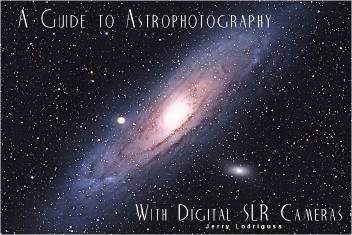 A Guide to Astrophotography with Digital SLR Cameras
A Guide to Astrophotography with Digital SLR Cameras
by Jerry Lodriguss
$39.95
Available on CD-ROM (Mac and PC) from http://www.astropix.com/GADC/GADC.HTM as a web browser based book.
To read this book will require a web browser. I used Apple Computer's Safari. One drawback to this is when you need to stop reading and resume later; you have to use the web browser's bookmark command, history feature, or drag out the current URL to your desktop (or other location). If you are using bookmarks, as you continue reading through the book you have to delete the previous bookmarks. Not a major problem but just something to be aware when reading this book. Most of the web pages and graphics for the book are on the CD-ROM but where appropriate there are links to web sites where you can find additional information. One distinct advantage of this web-browser-based book is that image rollovers can be used to change what is seen in the browser. When showing before and after photos, this works extremely well.
The book's main Table of Contents includes:
Gallery of Digital Astrophotography
1. Cameras for Astrophotography
2. Equipment for Digital Astrophotography
3. How Digital Cameras Work
4. Taking Pictures
5. Image Processing
6. Archiving and Output
Appendix
As explained in the book's Preface:
"The purpose of this book is to serve as a practical guide to astrophotography with digital single lens reflex (DSLR) cameras. It explains how digital cameras work and everything you need to know about how to take astrophotos with them. It also tells you how to digitally process the images after you have shot them, with step-by-step directions that will produce beautiful results."
Since I've using a Nikon D70 since April 2005 for astrophotography, I felt I could use some more knowledge on how to improve my images. It is for that reason that I purchased this book. Since I liked the author's last CD-ROM book "Photoshop for Astrophotographers", I trusted that this book would be beneficial as well. This review will let you know whether the book succeeded.
The book covers the author's real-world use of DSLRs for astrophotography and fully explains everything in a non-technical way. As you can see from the Table of Contents, the book covers just about all the questions you might have regarding DSLR astrophotography. Image processing techniques for both JPEG and RAW images are thoroughly discussed using Adobe Photoshop, although the techniques described are applicable to many other image processing tools. There are even video tutorials on image processing running more than 100 minutes. There are sample image files on the CD-ROM that you can use to learn the processing techniques described. One comment in the Introduction did surprise me: "Planetary photography is not discussed in depth because it can be done much better with inexpensive webcams." This is one area I was hoping to improve in my D70 astrophotography. If you don't already have a camera, then Chapter 1 is a good place to start your research. The author covers each type of imaging device and what it is good at.
The book covers simple as well as more complex astrophotography. So it is well suited to all levels of amateur astronomers who want to begin in astrophotography regardless of their telescope equipment. However, some comments might tend to make the reader shy away from doing astrophotography with some mounts. For example, the author states:
"Meade LXD 55 or LXD 75 (Made in the USA): Being made in the USA doesn't help this mount. While it is computerized Go To, and is acceptable for visual use with a small scope, it is not acceptable for anything except short-focal length piggyback astrophotography."
But as you can see from the many fine examples on my LXD55/75 web site, the LXD mount does allow some pretty good astrophotography to be done. However, he does go on to say:
"Almost any telescope can take pictures. How good they turn out will depend on the quality of the equipment (and especially the mount), your own personal standards, level of expertise, and the amount of work you put into it leaning and perfecting the craft."
On that I agree!
Chapter 3, How Digital Cameras Work, is a not-too-technical discussion of how images are captured. It could be skipped but the information in this chapter will let you maximize the quality of your images if you have at least a minimal understanding of the material.
Chapter 4, Taking Pictures, provides lots of information for beginning, intermediate, and advanced astrophotography. It starts simple, providing lots of basic information on how to get good pictures of astronomical objects with and without a telescope. So, even if you have never taken a photograph of the Moon, this book will get you going quickly. For the beginner, the author describes photography of these: The Moon, The Sun, Scenics, Star Trails, Constellations, and the Milky Way. Intermediate covers these topics: Afocal Photography, Wide-Angle Piggy-Back Photography, Telephoto Piggy-Back Photography, Prime-focus, Telecompressor / Tele-extender, an Eyepiece Projection. The Advanced Astrophotography section has a thorough discussion of Long-Exposure Deep-Sky Imaging (subtopics: Planning the Imaging Session, Equipment Setup, Camera Settings, Polar Alignment, Focusing, Target Acquisition and Framing, Guiding vs Tracking, Image and Support Frames, ISO and Exposure, Data Acquisition, File Formats, Downloading and Archiving, and Cheat Sheet), Filtered Shots, and High-Resolution Planetary Imaging. I was particularly interested in reading the section on Focusing as focusing my D70 DSLR is a challenge when used for astrophotography of faint objects. As the author notes:
"Focusing a DSLR can be one of the most difficult things in digital astrophotography."
Unfortunately, there were no magic solutions offered. Some tips I've already tried but it did give me a couple of ideas to pursue in the future.
Chapter 5 covers Image Processing. Here you will find indepth discussions of Color Management, Basic Processing for JPEG Images, Advanced Processing for Raw Images, and some Special Techniques. Previous chapters have been mostly on the hardware (camera and telescopes) and the mechanics of acquiring images. In this chapter you will learn to use software (Photoshop is used for the example descriptions) to process your astrophotography. If you follow the steps here you will likely dramatically improve your images, assuming that the images you have captured are improvable.
Chapter 6, Archiving and Output, discusses how to get the best results to showcase what you have accomplished and to be certain you will have stored the image and all the important facts about the image. The topics are Metadata; Archiving; Crop, Resize and Resample for Output; Sharpen Based on Output; Color Management and Printing; Output; and Resolution and File Sizes.
The Appendix has the following: References and Resources, Canon 20D and 20Da Setup, EquipmentT Tests, Formulas, Tables, Equipment Lists, Practice Files, Video Tutorials on Image Processing, Glossary, Searchable Index, and About the Author. The References and Resources is an excellent by-chapter listing of web pages or other sources of information. The only oversight I noticed was the lack of Macintosh software being listed; but the author is not a Mac user and so had no reason to research the many existing star charts and planetarium products such as Astroplanner, Voyager, and Starry Night, to name a few, for inclusion. He does include some Macintosh image processing applications but overlooks several excellent ones like GraphicConverter, Keith's Image Stacker, and Lynkeos. While the author offers setup guidance for the Canon 20D and 20Da models, much of the information will be applicable to most other DSLRs, with perhaps just some differences in terminology. Astrophotography tests are documented for some Nikon and Canon cameras but not the Nikon D50 or D70 models. Several video tutorials are included, running from about 2 minutes to 8 minutes in length. They use "Shockwave Flash" and they played just fine on my Mac OS X 10.4.7 system in Safari. Most of the tutorials discuss using Adobe Photoshop.
I decided to see if I could improve some Nikon D70 DSLR RAW images that I took in April and May 2006 at Oracle Observatory using some of the techniques described in the book. In just a few minutes of work I was able to slightly improve these two images over what I had previously done. But I think you can get the idea that the tips in the book are worthwhile, especially if you shoot with the tips in mind.
Comet Schwassmann-Wachmann 3, D70 piggybacked on the LXD-8"SC.
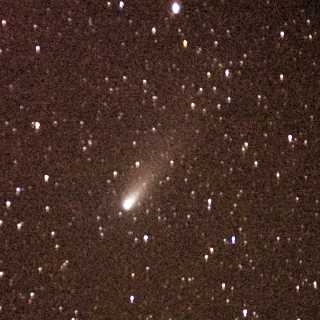
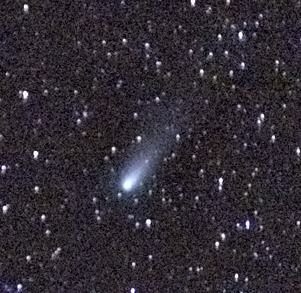
M57, the Ring Nebula in Lyra, D70 at Prime Focus of LXD75-8"SC.
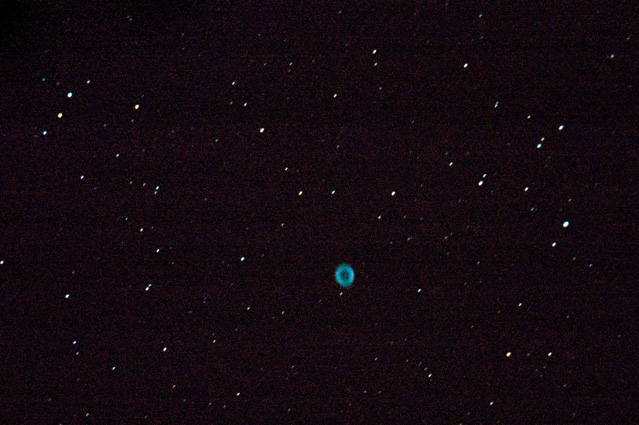
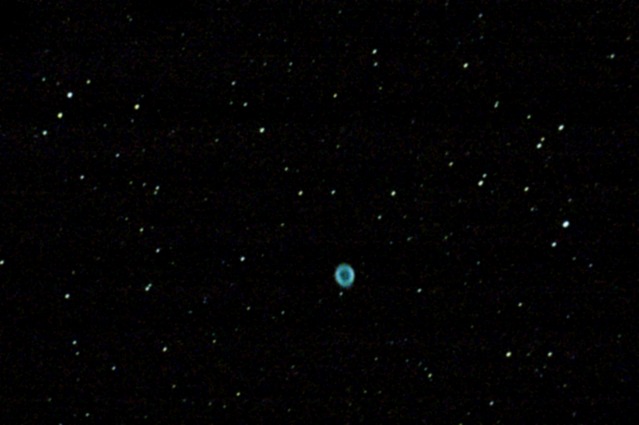
This book is full of good, time-saving tips, not only for doing astrophotography but for general observing as well. The author has obviously captured a lot of his personal experiences (both positive and negative) in his writing. Many of the examples in the book discuss using the Canon 20Da DSLR but even so, most of the information is applicable to any DSLR and in fact a lot is applicable to any digital camera. If you want to get more serious with your astrophotography with a DSLR, I highly recommend A Guide to Astrophotography with Digital SLR Cameras to get you started on the right path.
Return to the top of this page.
Go back to the Astrophotography Page.
Go back to my ETX Home Page.